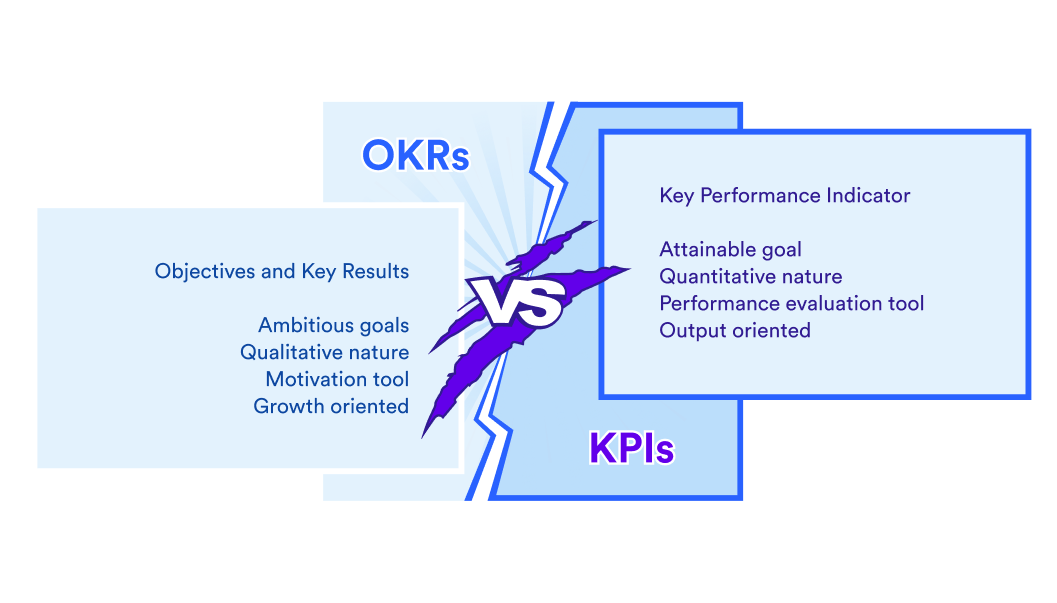OKRs vs KPIs: What’s the Difference and Why Does It Matter?

As businesses and organizations strive to achieve their goals and objectives, they often rely on two popular performance management tools – OKRs and KPIs. While both OKRs and KPIs are essential for tracking progress and measuring success, they are not the same thing. In this blog post, we’ll explore the differences between OKR vs KPI, and why understanding these differences is crucial for achieving success.
What are OKRs?
OKRs or Objectives and Key Results are a goal-setting framework that helps businesses and organizations to focus on what matters most. The objective is the desired outcome, while the key results are the metrics that measure progress towards the objective. OKRs are usually set at the beginning of a quarter or year and are typically ambitious but achievable.
For example, a company’s objective may be to increase revenue by 20% in the next quarter. To achieve this objective, the key results could include things like acquiring 50 new customers, launching a new product, or increasing average order value by 10%. The idea is that by setting clear objectives and measurable key results, teams can focus their efforts on what’s important and track their progress.
What are KPIs?
KPIs or Key Performance Indicators are a set of metrics that businesses use to track performance and measure progress towards their goals. Unlike OKRs, KPIs are not necessarily tied to specific objectives. Instead, KPIs are more focused on the day-to-day operations of the business and can be used to measure anything from sales performance to customer satisfaction.
For example, a company’s KPIs could include metrics like revenue growth, customer retention rate, website traffic, or social media engagement. These metrics help businesses to identify trends, track progress, and make data-driven decisions.
Key Differences between OKRs and KPIs
While OKRs and KPIs are both performance management tools, they differ in several ways. Here are some key differences between OKRs and KPIs:
Focus: OKRs are more focused on achieving specific objectives, while KPIs are more focused on measuring performance in specific areas of the business.
Measurement approach: OKRs are typically measured on a scale of 0-1, with 1 being the target, while KPIs are measured on a scale of 0-100%, with 100% being the target.
Flexibility: OKRs are more flexible than KPIs and can be adjusted throughout the quarter or year based on changing circumstances, while KPIs are usually set at the beginning of a period and remain the same throughout.
Timeframe: OKRs are usually set for a quarter or year, while KPIs can be measured on a daily, weekly, or monthly basis.
OKRs and KPIs in Practice

While OKRs and KPIs differ in several ways, they can be used in combination to achieve business objectives effectively. For example, a company could set OKRs for each quarter, focusing on specific objectives, and use KPIs to measure performance in key areas of the business.
To effectively use OKRs and KPIs in combination, it’s important to ensure that they are aligned with the overall business strategy. This means that the objectives and metrics should be tied to the company’s mission, vision, and values.
Here are some examples of how businesses have successfully implemented OKRs and KPIs:
Google: Google is famous for using OKRs to set ambitious goals and measure progress. For example, in 2018, Google set an OKR Software to reduce its carbon footprint by 100% by 2022, with key results including switching to renewable energy sources and reducing waste. At the same time, Google uses KPIs to track its daily operations, such as website traffic, ad revenue, and user engagement.
Airbnb: Airbnb uses OKRs to set objectives for its teams and KPIs to measure performance. For example, in 2019, Airbnb set an OKR to increase the number of unique stays booked on its platform by 25%, with key results including improving the search experience, expanding its inventory, and increasing customer loyalty. Airbnb uses KPIs such as average booking value, customer reviews, and host retention rate to track its progress towards these objectives.
HubSpot: HubSpot uses both OKRs and KPIs to achieve its goals. For example, in 2020, HubSpot set an OKR to increase annual recurring revenue by 35%, with key results including improving the sales process, expanding its product offerings, and increasing customer retention. HubSpot uses KPIs such as monthly recurring revenue, customer churn rate, and customer lifetime value to track its progress towards these objectives.
Why Does It Matter?
Understanding the differences between OKRs and KPIs is essential for businesses and organizations to achieve their goals effectively. By using OKRs to set specific objectives and KPIs to measure performance, businesses can focus their efforts on what’s important and track their progress towards their goals. This helps to ensure that teams are working towards the same objectives and that resources are being used effectively.
Moreover, using both OKRs and KPIs together helps to ensure that businesses are not just tracking their day-to-day operations but are also focused on achieving long-term objectives. This helps businesses to be more strategic in their decision-making, and ultimately, more successful in achieving their goals.
Conclusion
OKRs and KPIs are both essential performance management system tools that businesses use to track progress and achieve their goals. While they differ in several ways, they can be used in combination to achieve success. By understanding the differences between OKRs and KPIs and using them effectively, businesses can ensure that they are focused on what’s important, making data-driven decisions, and ultimately, achieving their objectives.
OKRs and KPIs are important tools that businesses can use to measure their performance and track progress towards their objectives. Understanding the differences between the two and using them effectively can help businesses to achieve their goals and be more successful in the long run.





